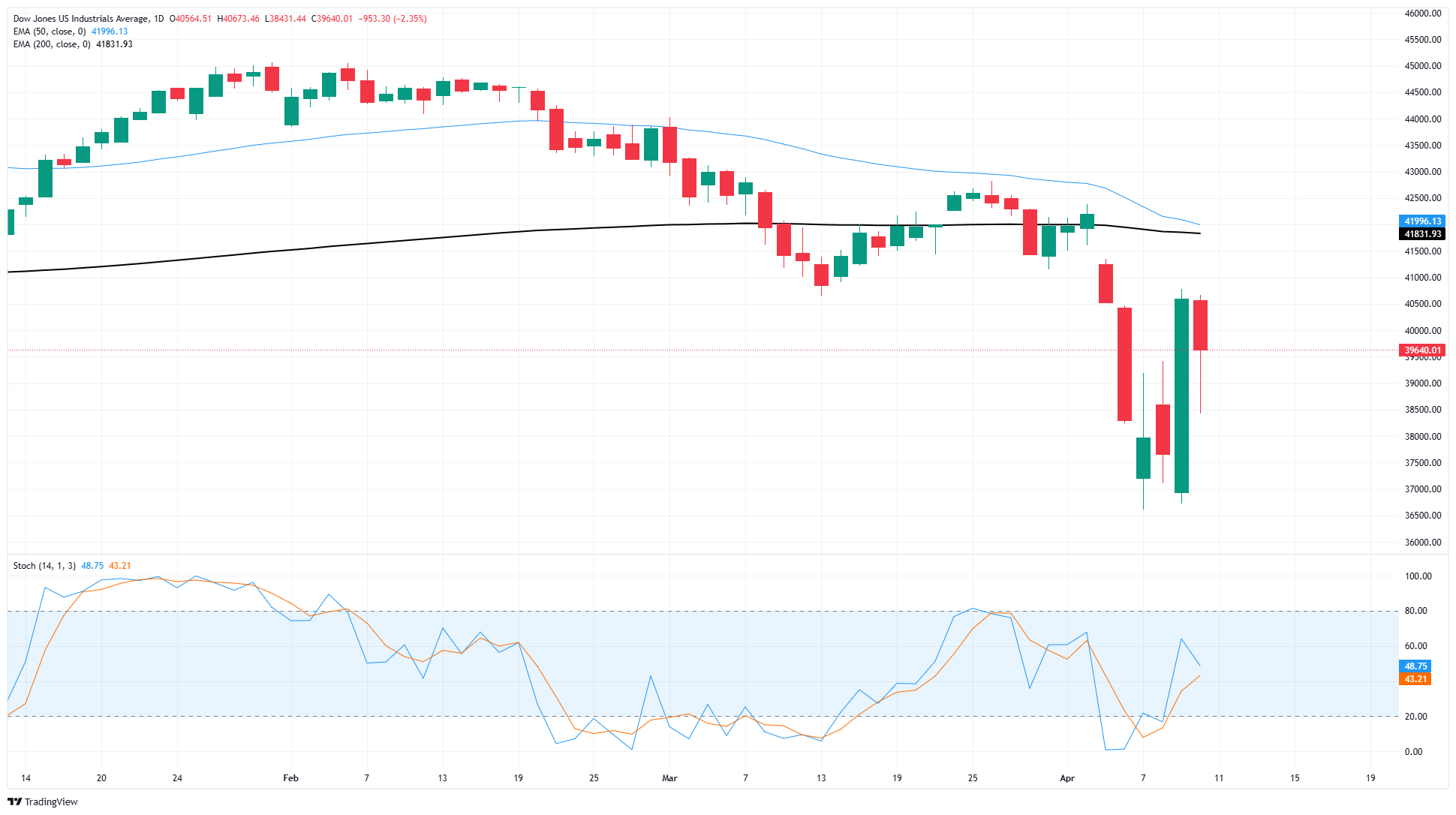Created
: 2025.04.11














![]() 2025.04.11 03:06
2025.04.11 03:06
The Dow Jones Industrial Average (DJIA) eased lower on Thursday, backsliding below the 40,000 handle as investors rethink this week's record-setting surge after the Trump administration announced yet another last-minute pivot away from its own confusing tariffs. Despite delaying the majority of President Trump's "reciprocal" tariffs, an across-the-board 10% import levy is still in effect during the 90-day 'grace period', and a 145% tariff on all Chinese imports is still in effect.
On top of the eye-watering 145% tariff on Chinese goods, China has slapped its own 84% retaliatory tariff on all imports from the US, which will overwhelmingly impact US agriculture and energy, two darlings of the Trump administration. Additionally, the 10% interim tariff also applies to all goods from Canada and Mexico and promises to cause pricing problems for US consumers, who remain notably sensitive to upside price pressures.
Read more stock news: US stocks slide after historic Wednesday rally, NASDAQ down 5.7% on Thursday
US Consumer Price Index (CPI) inflation came in well below expectations in March. Core CPI eased to 2.8% YoY, reaching a four-year low after stubbornly holding above 3.0% for nearly eight months. Headline CPI inflation also eased to 2.4% YoY, and investment markets will be devastated if tariffs undo years' worth of work by the Federal Reserve (Fed) to bring inflation to heel.
This week will wrap up with University of Michigan (UoM) Consumer Sentiment Index survey results on Friday. The UoM Consumer Sentiment Index is expected to contract yet again in April as consumers continue to buckle under the weight of the Trump administration's tariff and trade "strategy", and is expected to sink to a nearly three-year low of 54.5. Consumer Inflation Expectations are also on the cards for Friday. UoM 1-year and 5-year Consumer Inflation Expectations last clocked in at 5% and 4.1%, respectively.
Despite a wild mid-week recovery, the Dow Jones still found some room on the low side on Thursday, paring away some of the index's near-term gains and keeping the 40,000 major price handle in play. The Dow Jones is trading in a wide, choppy range on the low side of the 200-day Exponential Moving Average (EMA) near 41,900.

The Dow Jones Industrial Average, one of the oldest stock market indices in the world, is compiled of the 30 most traded stocks in the US. The index is price-weighted rather than weighted by capitalization. It is calculated by summing the prices of the constituent stocks and dividing them by a factor, currently 0.152. The index was founded by Charles Dow, who also founded the Wall Street Journal. In later years it has been criticized for not being broadly representative enough because it only tracks 30 conglomerates, unlike broader indices such as the S&P 500.
Many different factors drive the Dow Jones Industrial Average (DJIA). The aggregate performance of the component companies revealed in quarterly company earnings reports is the main one. US and global macroeconomic data also contributes as it impacts on investor sentiment. The level of interest rates, set by the Federal Reserve (Fed), also influences the DJIA as it affects the cost of credit, on which many corporations are heavily reliant. Therefore, inflation can be a major driver as well as other metrics which impact the Fed decisions.
Dow Theory is a method for identifying the primary trend of the stock market developed by Charles Dow. A key step is to compare the direction of the Dow Jones Industrial Average (DJIA) and the Dow Jones Transportation Average (DJTA) and only follow trends where both are moving in the same direction. Volume is a confirmatory criteria. The theory uses elements of peak and trough analysis. Dow's theory posits three trend phases: accumulation, when smart money starts buying or selling; public participation, when the wider public joins in; and distribution, when the smart money exits.
There are a number of ways to trade the DJIA. One is to use ETFs which allow investors to trade the DJIA as a single security, rather than having to buy shares in all 30 constituent companies. A leading example is the SPDR Dow Jones Industrial Average ETF (DIA). DJIA futures contracts enable traders to speculate on the future value of the index and Options provide the right, but not the obligation, to buy or sell the index at a predetermined price in the future. Mutual funds enable investors to buy a share of a diversified portfolio of DJIA stocks thus providing exposure to the overall index.
![]()
Created
: 2025.04.11
![]()
Last updated
: 2025.04.11

FXStreet is a forex information website, delivering market analysis and news articles 24/7.
It features a number of articles contributed by well-known analysts, in addition to the ones by its editorial team.
Founded in 2000 by Francesc Riverola, a Spanish economist, it has grown to become a world-renowned information website.
We hope you find this article useful. Any comments or suggestions will be greatly appreciated.
We are also looking for writers with extensive experience in forex and crypto to join us.
please contact us at [email protected].
Disclaimer:
All information and content provided on this website is provided for informational purposes only and is not intended to solicit any investment. Although all efforts are made in order to ensure that the information is correct, no guarantee is provided for the accuracy of any content on this website. Any decision made shall be the responsibility of the investor and Myforex does not take any responsibility whatsoever regarding the use of any information provided herein.
The content provided on this website belongs to Myforex and, where stated, the relevant licensors. All rights are reserved by Myforex and the relevant licensors, and no content of this website, whether in full or in part, shall be copied or displayed elsewhere without the explicit written permission of the relevant copyright holder. If you wish to use any part of the content provided on this website, please ensure that you contact Myforex.
Myforex uses cookies to improve the convenience and functionality of this website. This website may include cookies not only by us but also by third parties (advertisers, log analysts, etc.) for the purpose of tracking the activities of users. Cookie policy